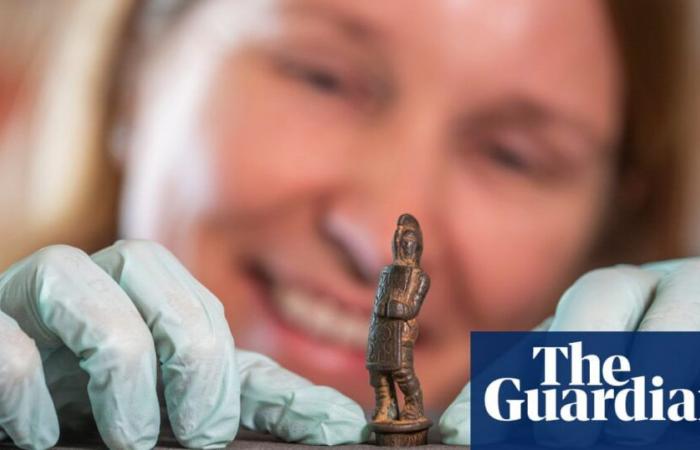A rare and pristine example of gladiator memorabilia found in the River Tyne is to go on display, shining light on a 2,000-year-old culture of celebrity and sex appeal.
English Heritage said the copper alloy figurine would have been a decorative handle on a folding knife. Found near Corbridge, Northumberland, it provides proof that the superstar status of gladiators extended to the far edges of the Roman empire.
“It is amazing, it’s absolutely pristine,” said Frances McIntosh, English Heritage’s collections curator for Hadrian’s Wall. It is rare to find any example of gladiator memorabilia in Britain but “to find such a well-preserved and interesting piece is remarkable”.
“This beautifully made knife handle is a testament to how pervasive this celebrity culture was, reaching all the way to Hadrian’s Wall at the very edge of the Roman empire.”
McIntosh said successful gladiators became celebrities and had sex appeal. “There are lots of rumours that you see of high society women falling in love with gladiators,” she said. “Often a slur on somebody was that they had been fathered by a gladiator, that they were the son of a gladiator because their mother was … you know.”
The handle will go on display in 2025. The news coincides with the release this week of Ridley Scott’s Gladiator II, 24 years after the original, starring Russell Crowe.
The new film, starring Paul Mescal, has divided critics, with the Guardian calling it “thrilling” and the Times calling it “dreary”.
For some Roman history experts, however, it is a question of accuracy, with some bridling at scenes such as a gladiator riding a rhino – “suicidal” – and the Colosseum being filled with water and sharks. “The Romans were not at all familiar with the shark as a beast,” the classics academic Kathleen Coleman told the BBC.
Nor would they always fight to the death, said McIntosh. “Training a gladiator is a huge investment. They can’t be dying every time.”
The Tyne knife handle depicts a gladiator known as a secutor, a muscular fighter who carried heavy equipment including a large shield, a heavy helmet with limited visibility, and a sword.
A secutor was trained to fight a gladiator called a retiarius, a more nimble and unencumbered fighter who carried a net, a trident and a dagger. A retiarius fought without his face covered, which meant the best-looking men were often chosen for the role.
The gladiator fighting would usually complete a day of entertainment which began with animal hunts and was followed by prisoner executions.
The Tyne object shows someone who is left-handed, which is unusual as it was regarded as bad luck.
“It could be that it is a very specific gladiator because gladiators were celebrity culture in the Roman world,” said McIntosh. “Gladiators were big and individual gladiators, if they won multiple bouts, then they become better known.”
How the souvenir ended up in the river is a mystery. “You always wonder,” said McIntosh. “Did it fall out of someone’s pocket? Did someone throw it in? This is probably a one-off commission and you would be pretty annoyed if you lost it.”
English Heritage said it planned to display the souvenir at Corbridge Roman Town in 2025 along with other finds from the Tyne.






